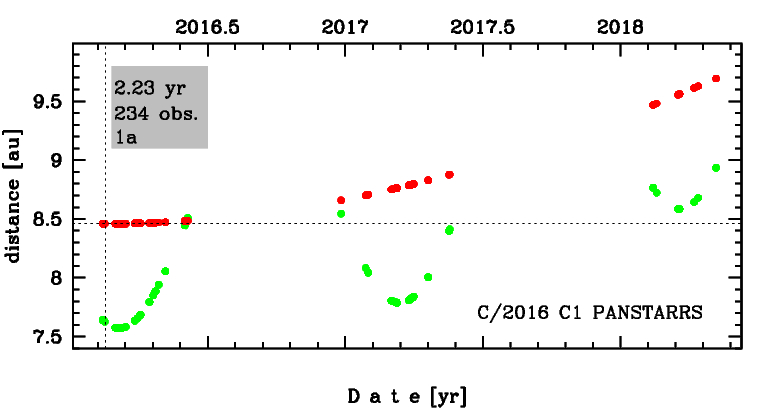C/2016 C1 PANSTARRS
more info
Comet C/2016 C1 was discovered on 12 February 2016 with Pan-STARRS 1 telescope (Haleakala), that is a week before its perihelion passage. This comet was observed until 24 May 2020.
Comet had its closest approach to the Earth on 5 March 2016 (7.572 au), about 2 weeks after its perihelion passage.
The preferred solution given here is based on data spanning over 4.28 yr in a range of heliocentric distances: 8.46 au – 8.46 au (perihelion) – 12.3 au.
This Oort spike comet suffers small planetary perturbations during its passage through the planetary system; however, these perturbations likely lead to escape the comet from the planetary zone on a hyperbolic orbit (see future barycentric orbits).
Comet had its closest approach to the Earth on 5 March 2016 (7.572 au), about 2 weeks after its perihelion passage.
The preferred solution given here is based on data spanning over 4.28 yr in a range of heliocentric distances: 8.46 au – 8.46 au (perihelion) – 12.3 au.
This Oort spike comet suffers small planetary perturbations during its passage through the planetary system; however, these perturbations likely lead to escape the comet from the planetary zone on a hyperbolic orbit (see future barycentric orbits).
| solution description | ||
|---|---|---|
| number of observations | 234 | |
| data interval | 2016 02 12 – 2018 05 06 | |
| data type | significantly more measurements after perihelion (POST+) | |
| data arc selection | entire data set (STD) | |
| range of heliocentric distances | 8.46 au – 8.46 au (perihelion) – 9.69 au | |
| detectability of NG effects in the comet's motion | NG effects not determinable | |
| type of model of motion | GR - gravitational orbit | |
| data weighting | YES | |
| number of residuals | 464 | |
| RMS [arcseconds] | 0.56 | |
| orbit quality class | 1a | |
| next orbit statistics, both Galactic and stellar perturbations were taken into account | ||
|---|---|---|
| no. of returning VCs in the swarm | 0 | |
| no. of escaping VCs in the swarm | 5001 | |
| no. of hyperbolas among escaping VCs in the swarm | 5001 | * |
| next reciprocal semi-major axis [10-6 au-1] | -144.79 – -143.32 – -141.86 | |
| next perihelion distance [au] | 109.6 – 110.3 – 111 | |
| synchronous stop epoch [Myr] | 1.35 | S |
| percentage of VCs with qnext > 20 | 100 | |
| next_g orbit statistics, here only the Galactic tide has been included | ||
|---|---|---|
| no. of returning VCs in the swarm | 0 | |
| no. of escaping VCs in the swarm | 5001 | |
| no. of hyperbolas among escaping VCs in the swarm | 5001 | * |
| next reciprocal semi-major axis [10-6 au-1] | -139.85 – -138.40 – -136.96 | |
| next perihelion distance [au] | 1.31 – 1.34 – 1.36 | |
| synchronous stop epoch [Myr] | 1.4 | S |
| percentage of VCs with qnext < 10 | 100 | |
